Impact of Changes in Strategy and Operations on Organizational Behaviour - Tesco Case Study
VerifiedAdded on 2023/06/07
|17
|4945
|414
AI Summary
This report discusses the impacts of changes in strategy and operations on organizational behaviour with the help of Tesco case study. It covers various theories, models, and drivers of change, along with barriers and leadership approaches to deal with change.
Contribute Materials
Your contribution can guide someone’s learning journey. Share your
documents today.

Unit 17
Secure Best Marks with AI Grader
Need help grading? Try our AI Grader for instant feedback on your assignments.

Contents
INTRODUCTION...........................................................................................................................3
TASK...............................................................................................................................................3
P1 With the help of example disclose the impacts of changes in the strategy and operations of
an organization.............................................................................................................................3
M1 Measures the drivers of the change.......................................................................................7
P2 Assess the ways of change drivers which effect individual, team and leadership behaviour.
.....................................................................................................................................................7
P3 Measures to understate the negative impacts of changes on the organizational behaviour. 10
M2 Evaluate the response of organizational change by applying the theories and models.......11
D1 Conclusion and recommendations with valid justification..................................................11
P4 Define the barriers for change and their impacts on leadership decision making................11
M3. Use force field analysis to evaluate the driving forces......................................................13
D2. Evaluation of Forcefield model in meeting objectives of company...................................14
P5 Application of leadership approaches to deal with the organizational changes...................14
M4 Examine the leadership approach by using appropriate methods and theories...................15
D3 Critically evaluate the effectiveness of leadership approaches and models for change
management...............................................................................................................................15
CONCLUSION..............................................................................................................................15
REFERENCES..............................................................................................................................17
INTRODUCTION...........................................................................................................................3
TASK...............................................................................................................................................3
P1 With the help of example disclose the impacts of changes in the strategy and operations of
an organization.............................................................................................................................3
M1 Measures the drivers of the change.......................................................................................7
P2 Assess the ways of change drivers which effect individual, team and leadership behaviour.
.....................................................................................................................................................7
P3 Measures to understate the negative impacts of changes on the organizational behaviour. 10
M2 Evaluate the response of organizational change by applying the theories and models.......11
D1 Conclusion and recommendations with valid justification..................................................11
P4 Define the barriers for change and their impacts on leadership decision making................11
M3. Use force field analysis to evaluate the driving forces......................................................13
D2. Evaluation of Forcefield model in meeting objectives of company...................................14
P5 Application of leadership approaches to deal with the organizational changes...................14
M4 Examine the leadership approach by using appropriate methods and theories...................15
D3 Critically evaluate the effectiveness of leadership approaches and models for change
management...............................................................................................................................15
CONCLUSION..............................................................................................................................15
REFERENCES..............................................................................................................................17
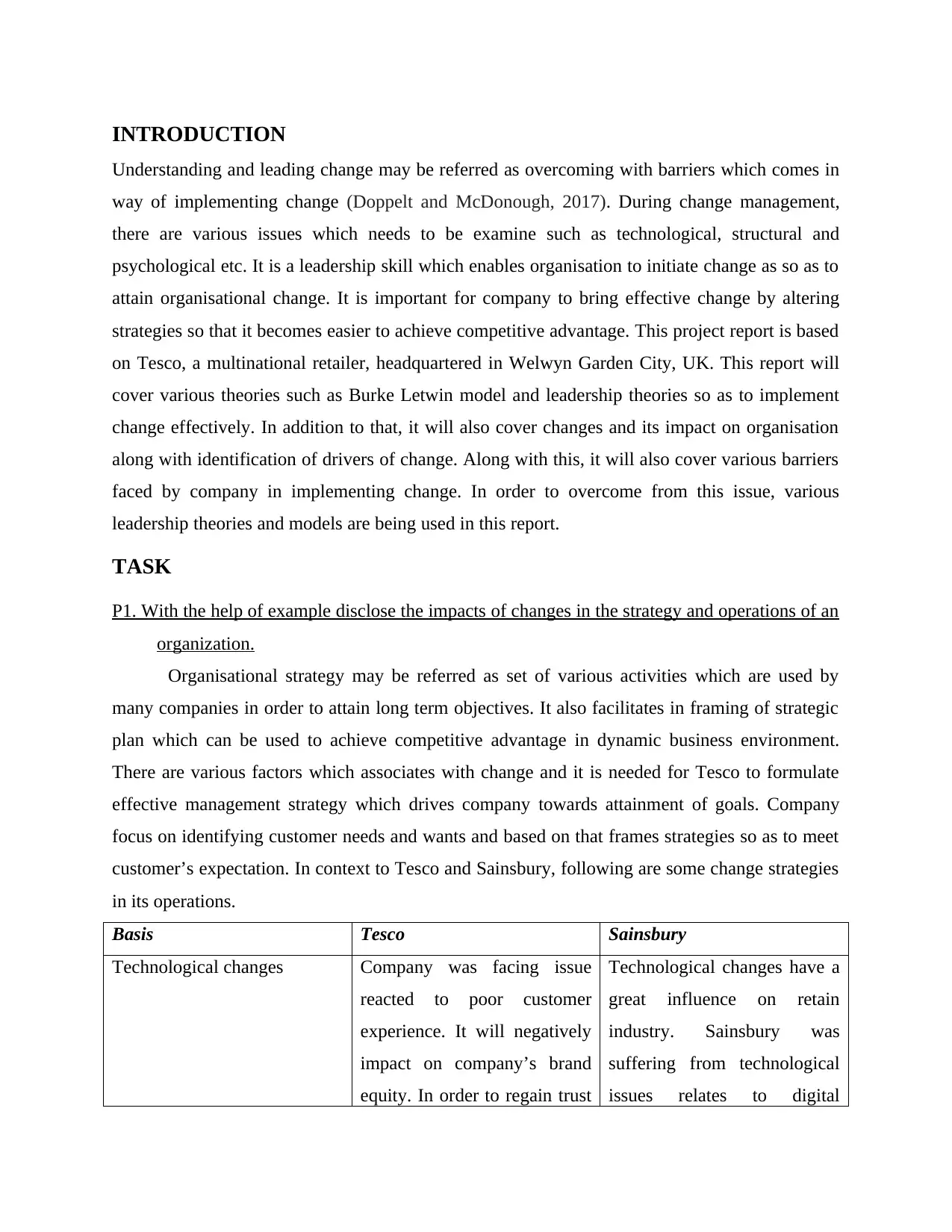
INTRODUCTION
Understanding and leading change may be referred as overcoming with barriers which comes in
way of implementing change (Doppelt and McDonough, 2017). During change management,
there are various issues which needs to be examine such as technological, structural and
psychological etc. It is a leadership skill which enables organisation to initiate change as so as to
attain organisational change. It is important for company to bring effective change by altering
strategies so that it becomes easier to achieve competitive advantage. This project report is based
on Tesco, a multinational retailer, headquartered in Welwyn Garden City, UK. This report will
cover various theories such as Burke Letwin model and leadership theories so as to implement
change effectively. In addition to that, it will also cover changes and its impact on organisation
along with identification of drivers of change. Along with this, it will also cover various barriers
faced by company in implementing change. In order to overcome from this issue, various
leadership theories and models are being used in this report.
TASK
P1. With the help of example disclose the impacts of changes in the strategy and operations of an
organization.
Organisational strategy may be referred as set of various activities which are used by
many companies in order to attain long term objectives. It also facilitates in framing of strategic
plan which can be used to achieve competitive advantage in dynamic business environment.
There are various factors which associates with change and it is needed for Tesco to formulate
effective management strategy which drives company towards attainment of goals. Company
focus on identifying customer needs and wants and based on that frames strategies so as to meet
customer’s expectation. In context to Tesco and Sainsbury, following are some change strategies
in its operations.
Basis Tesco Sainsbury
Technological changes Company was facing issue
reacted to poor customer
experience. It will negatively
impact on company’s brand
equity. In order to regain trust
Technological changes have a
great influence on retain
industry. Sainsbury was
suffering from technological
issues relates to digital
Understanding and leading change may be referred as overcoming with barriers which comes in
way of implementing change (Doppelt and McDonough, 2017). During change management,
there are various issues which needs to be examine such as technological, structural and
psychological etc. It is a leadership skill which enables organisation to initiate change as so as to
attain organisational change. It is important for company to bring effective change by altering
strategies so that it becomes easier to achieve competitive advantage. This project report is based
on Tesco, a multinational retailer, headquartered in Welwyn Garden City, UK. This report will
cover various theories such as Burke Letwin model and leadership theories so as to implement
change effectively. In addition to that, it will also cover changes and its impact on organisation
along with identification of drivers of change. Along with this, it will also cover various barriers
faced by company in implementing change. In order to overcome from this issue, various
leadership theories and models are being used in this report.
TASK
P1. With the help of example disclose the impacts of changes in the strategy and operations of an
organization.
Organisational strategy may be referred as set of various activities which are used by
many companies in order to attain long term objectives. It also facilitates in framing of strategic
plan which can be used to achieve competitive advantage in dynamic business environment.
There are various factors which associates with change and it is needed for Tesco to formulate
effective management strategy which drives company towards attainment of goals. Company
focus on identifying customer needs and wants and based on that frames strategies so as to meet
customer’s expectation. In context to Tesco and Sainsbury, following are some change strategies
in its operations.
Basis Tesco Sainsbury
Technological changes Company was facing issue
reacted to poor customer
experience. It will negatively
impact on company’s brand
equity. In order to regain trust
Technological changes have a
great influence on retain
industry. Sainsbury was
suffering from technological
issues relates to digital
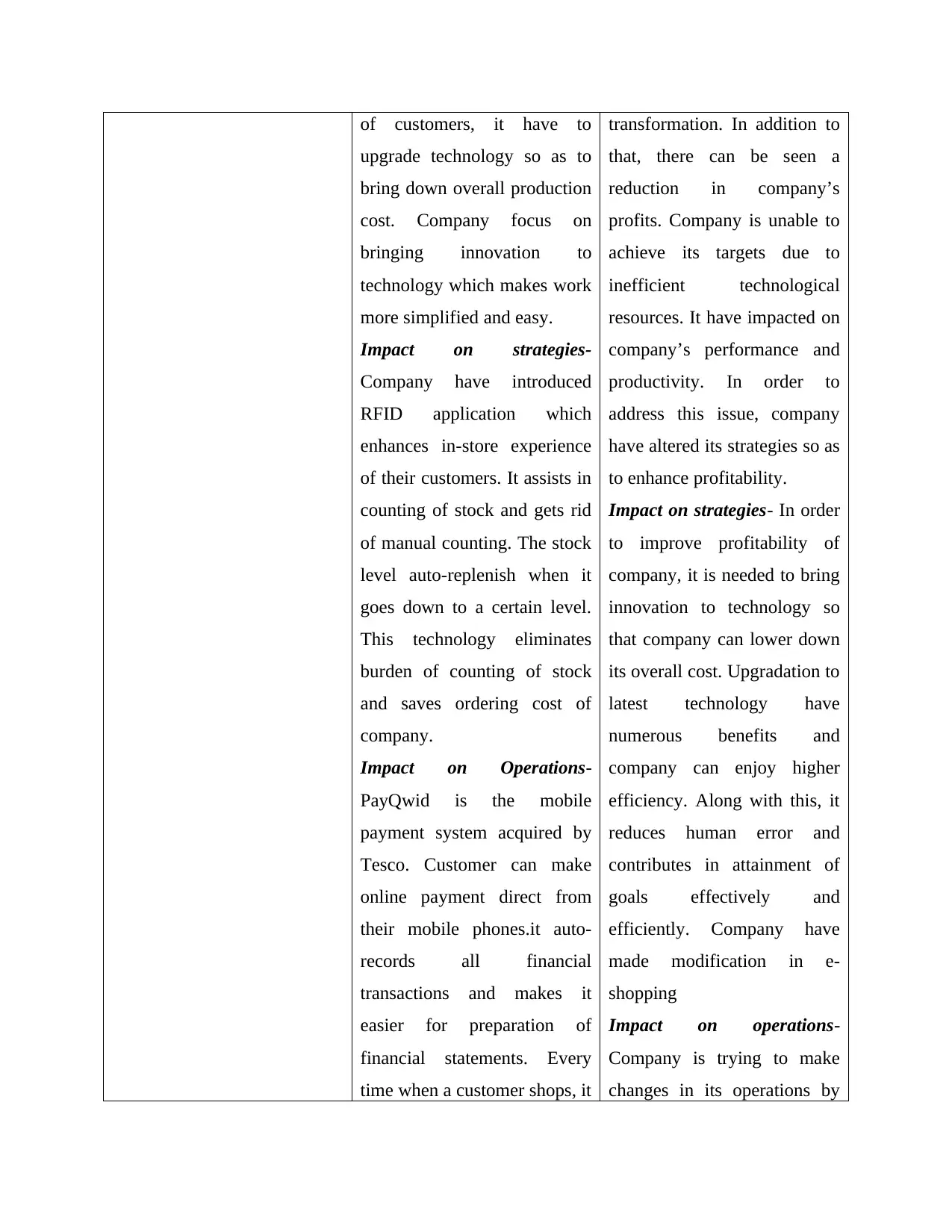
of customers, it have to
upgrade technology so as to
bring down overall production
cost. Company focus on
bringing innovation to
technology which makes work
more simplified and easy.
Impact on strategies-
Company have introduced
RFID application which
enhances in-store experience
of their customers. It assists in
counting of stock and gets rid
of manual counting. The stock
level auto-replenish when it
goes down to a certain level.
This technology eliminates
burden of counting of stock
and saves ordering cost of
company.
Impact on Operations-
PayQwid is the mobile
payment system acquired by
Tesco. Customer can make
online payment direct from
their mobile phones.it auto-
records all financial
transactions and makes it
easier for preparation of
financial statements. Every
time when a customer shops, it
transformation. In addition to
that, there can be seen a
reduction in company’s
profits. Company is unable to
achieve its targets due to
inefficient technological
resources. It have impacted on
company’s performance and
productivity. In order to
address this issue, company
have altered its strategies so as
to enhance profitability.
Impact on strategies- In order
to improve profitability of
company, it is needed to bring
innovation to technology so
that company can lower down
its overall cost. Upgradation to
latest technology have
numerous benefits and
company can enjoy higher
efficiency. Along with this, it
reduces human error and
contributes in attainment of
goals effectively and
efficiently. Company have
made modification in e-
shopping
Impact on operations-
Company is trying to make
changes in its operations by
upgrade technology so as to
bring down overall production
cost. Company focus on
bringing innovation to
technology which makes work
more simplified and easy.
Impact on strategies-
Company have introduced
RFID application which
enhances in-store experience
of their customers. It assists in
counting of stock and gets rid
of manual counting. The stock
level auto-replenish when it
goes down to a certain level.
This technology eliminates
burden of counting of stock
and saves ordering cost of
company.
Impact on Operations-
PayQwid is the mobile
payment system acquired by
Tesco. Customer can make
online payment direct from
their mobile phones.it auto-
records all financial
transactions and makes it
easier for preparation of
financial statements. Every
time when a customer shops, it
transformation. In addition to
that, there can be seen a
reduction in company’s
profits. Company is unable to
achieve its targets due to
inefficient technological
resources. It have impacted on
company’s performance and
productivity. In order to
address this issue, company
have altered its strategies so as
to enhance profitability.
Impact on strategies- In order
to improve profitability of
company, it is needed to bring
innovation to technology so
that company can lower down
its overall cost. Upgradation to
latest technology have
numerous benefits and
company can enjoy higher
efficiency. Along with this, it
reduces human error and
contributes in attainment of
goals effectively and
efficiently. Company have
made modification in e-
shopping
Impact on operations-
Company is trying to make
changes in its operations by
Secure Best Marks with AI Grader
Need help grading? Try our AI Grader for instant feedback on your assignments.
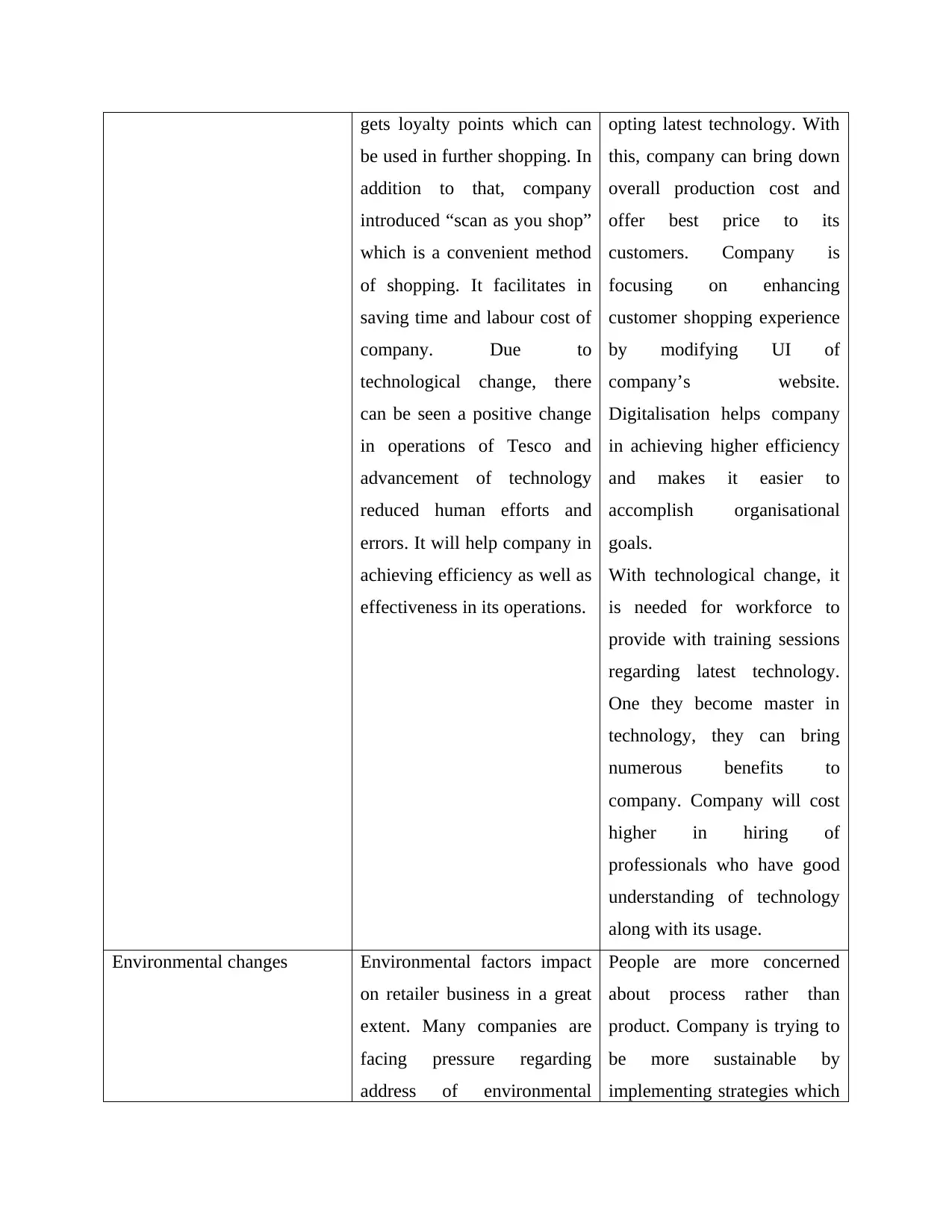
gets loyalty points which can
be used in further shopping. In
addition to that, company
introduced “scan as you shop”
which is a convenient method
of shopping. It facilitates in
saving time and labour cost of
company. Due to
technological change, there
can be seen a positive change
in operations of Tesco and
advancement of technology
reduced human efforts and
errors. It will help company in
achieving efficiency as well as
effectiveness in its operations.
opting latest technology. With
this, company can bring down
overall production cost and
offer best price to its
customers. Company is
focusing on enhancing
customer shopping experience
by modifying UI of
company’s website.
Digitalisation helps company
in achieving higher efficiency
and makes it easier to
accomplish organisational
goals.
With technological change, it
is needed for workforce to
provide with training sessions
regarding latest technology.
One they become master in
technology, they can bring
numerous benefits to
company. Company will cost
higher in hiring of
professionals who have good
understanding of technology
along with its usage.
Environmental changes Environmental factors impact
on retailer business in a great
extent. Many companies are
facing pressure regarding
address of environmental
People are more concerned
about process rather than
product. Company is trying to
be more sustainable by
implementing strategies which
be used in further shopping. In
addition to that, company
introduced “scan as you shop”
which is a convenient method
of shopping. It facilitates in
saving time and labour cost of
company. Due to
technological change, there
can be seen a positive change
in operations of Tesco and
advancement of technology
reduced human efforts and
errors. It will help company in
achieving efficiency as well as
effectiveness in its operations.
opting latest technology. With
this, company can bring down
overall production cost and
offer best price to its
customers. Company is
focusing on enhancing
customer shopping experience
by modifying UI of
company’s website.
Digitalisation helps company
in achieving higher efficiency
and makes it easier to
accomplish organisational
goals.
With technological change, it
is needed for workforce to
provide with training sessions
regarding latest technology.
One they become master in
technology, they can bring
numerous benefits to
company. Company will cost
higher in hiring of
professionals who have good
understanding of technology
along with its usage.
Environmental changes Environmental factors impact
on retailer business in a great
extent. Many companies are
facing pressure regarding
address of environmental
People are more concerned
about process rather than
product. Company is trying to
be more sustainable by
implementing strategies which
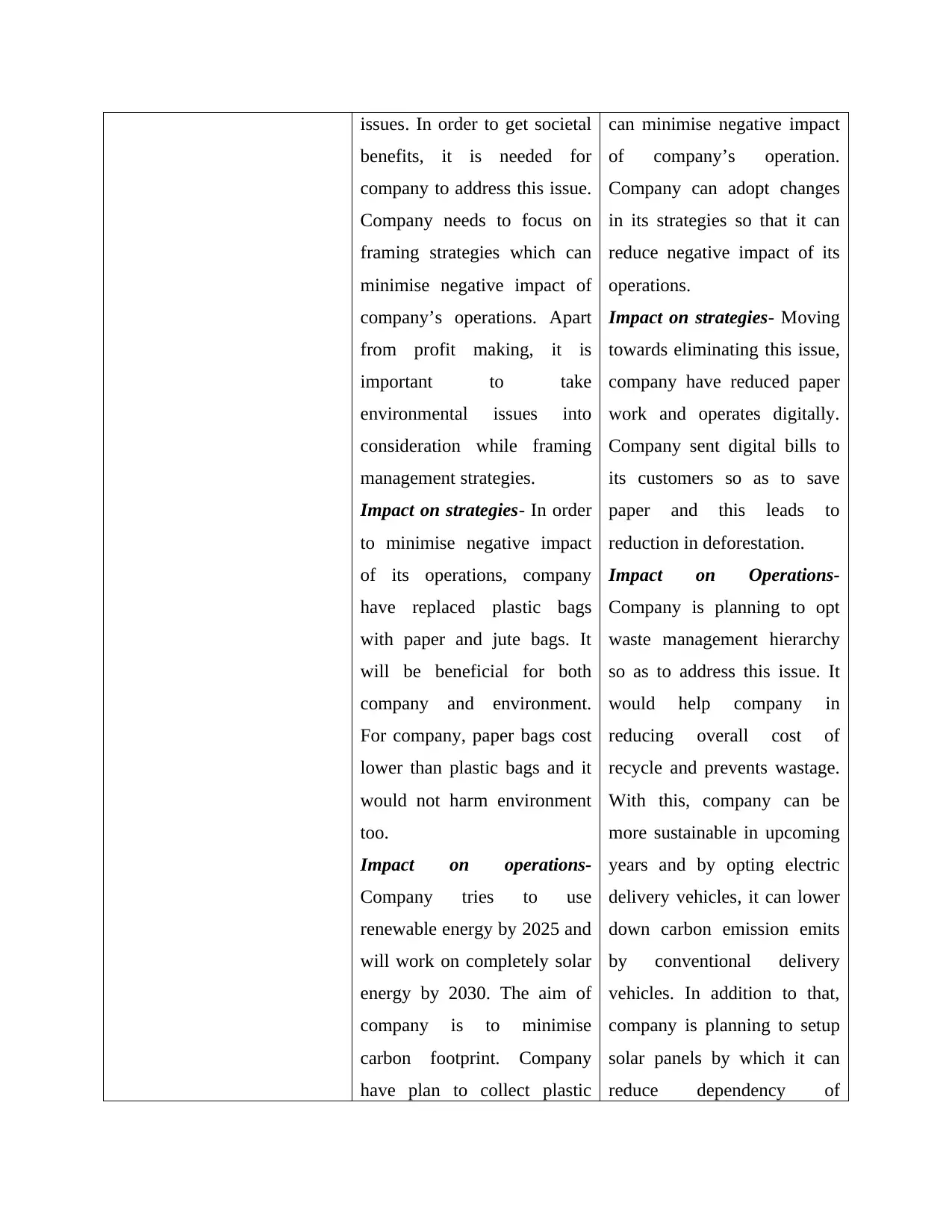
issues. In order to get societal
benefits, it is needed for
company to address this issue.
Company needs to focus on
framing strategies which can
minimise negative impact of
company’s operations. Apart
from profit making, it is
important to take
environmental issues into
consideration while framing
management strategies.
Impact on strategies- In order
to minimise negative impact
of its operations, company
have replaced plastic bags
with paper and jute bags. It
will be beneficial for both
company and environment.
For company, paper bags cost
lower than plastic bags and it
would not harm environment
too.
Impact on operations-
Company tries to use
renewable energy by 2025 and
will work on completely solar
energy by 2030. The aim of
company is to minimise
carbon footprint. Company
have plan to collect plastic
can minimise negative impact
of company’s operation.
Company can adopt changes
in its strategies so that it can
reduce negative impact of its
operations.
Impact on strategies- Moving
towards eliminating this issue,
company have reduced paper
work and operates digitally.
Company sent digital bills to
its customers so as to save
paper and this leads to
reduction in deforestation.
Impact on Operations-
Company is planning to opt
waste management hierarchy
so as to address this issue. It
would help company in
reducing overall cost of
recycle and prevents wastage.
With this, company can be
more sustainable in upcoming
years and by opting electric
delivery vehicles, it can lower
down carbon emission emits
by conventional delivery
vehicles. In addition to that,
company is planning to setup
solar panels by which it can
reduce dependency of
benefits, it is needed for
company to address this issue.
Company needs to focus on
framing strategies which can
minimise negative impact of
company’s operations. Apart
from profit making, it is
important to take
environmental issues into
consideration while framing
management strategies.
Impact on strategies- In order
to minimise negative impact
of its operations, company
have replaced plastic bags
with paper and jute bags. It
will be beneficial for both
company and environment.
For company, paper bags cost
lower than plastic bags and it
would not harm environment
too.
Impact on operations-
Company tries to use
renewable energy by 2025 and
will work on completely solar
energy by 2030. The aim of
company is to minimise
carbon footprint. Company
have plan to collect plastic
can minimise negative impact
of company’s operation.
Company can adopt changes
in its strategies so that it can
reduce negative impact of its
operations.
Impact on strategies- Moving
towards eliminating this issue,
company have reduced paper
work and operates digitally.
Company sent digital bills to
its customers so as to save
paper and this leads to
reduction in deforestation.
Impact on Operations-
Company is planning to opt
waste management hierarchy
so as to address this issue. It
would help company in
reducing overall cost of
recycle and prevents wastage.
With this, company can be
more sustainable in upcoming
years and by opting electric
delivery vehicles, it can lower
down carbon emission emits
by conventional delivery
vehicles. In addition to that,
company is planning to setup
solar panels by which it can
reduce dependency of

bags and items from its
customers and will recycle.
This type of changes will
impact on company’s
operation. For Tesco,
environmental factors creates
restrictions which negatively
impact on company’s
operations and it becomes
difficult to implement change.
electricity over power grids.
With its environmental
strategies, company limits
utilisation of natural resources
and fostered sustainable
practices.
M1 Measures the drivers of the change.
There are two types of drivers which contributes in modification of strategies, policies,
designs, services and products. The internal driver may involve capabilities, culture, rules
and regulations which are complex to change but an establishment have full control to
change (NAGENDRA and FAROOQUI, 2016). External drivers may involve customers,
government policies and on which organisation have no control.
Types of organizational change:
Development change- This type of change occurs when a company tries to improve its
existing situation. In relation to Tesco, it plans to develop software which aids in shopping
experience and becomes convenient for customers. It will help company in achieving
higher efficiency.
Transitional change- This type of change occurs when c company wants to implement
new course of action (Nelson and Luetz, 2019). In relation to Tesco, it wants to bring down
overall cost of production by upgrading technology. It will reduce manpower and
beneficial for company in various aspects.
P2 Assess the ways of change drivers which effect individual, team and leadership behaviour.
In relation to Tesco, there are two drivers that may influence behaviour of team,
individual as well as leadership.
Internal drivers-
customers and will recycle.
This type of changes will
impact on company’s
operation. For Tesco,
environmental factors creates
restrictions which negatively
impact on company’s
operations and it becomes
difficult to implement change.
electricity over power grids.
With its environmental
strategies, company limits
utilisation of natural resources
and fostered sustainable
practices.
M1 Measures the drivers of the change.
There are two types of drivers which contributes in modification of strategies, policies,
designs, services and products. The internal driver may involve capabilities, culture, rules
and regulations which are complex to change but an establishment have full control to
change (NAGENDRA and FAROOQUI, 2016). External drivers may involve customers,
government policies and on which organisation have no control.
Types of organizational change:
Development change- This type of change occurs when a company tries to improve its
existing situation. In relation to Tesco, it plans to develop software which aids in shopping
experience and becomes convenient for customers. It will help company in achieving
higher efficiency.
Transitional change- This type of change occurs when c company wants to implement
new course of action (Nelson and Luetz, 2019). In relation to Tesco, it wants to bring down
overall cost of production by upgrading technology. It will reduce manpower and
beneficial for company in various aspects.
P2 Assess the ways of change drivers which effect individual, team and leadership behaviour.
In relation to Tesco, there are two drivers that may influence behaviour of team,
individual as well as leadership.
Internal drivers-
Paraphrase This Document
Need a fresh take? Get an instant paraphrase of this document with our AI Paraphraser
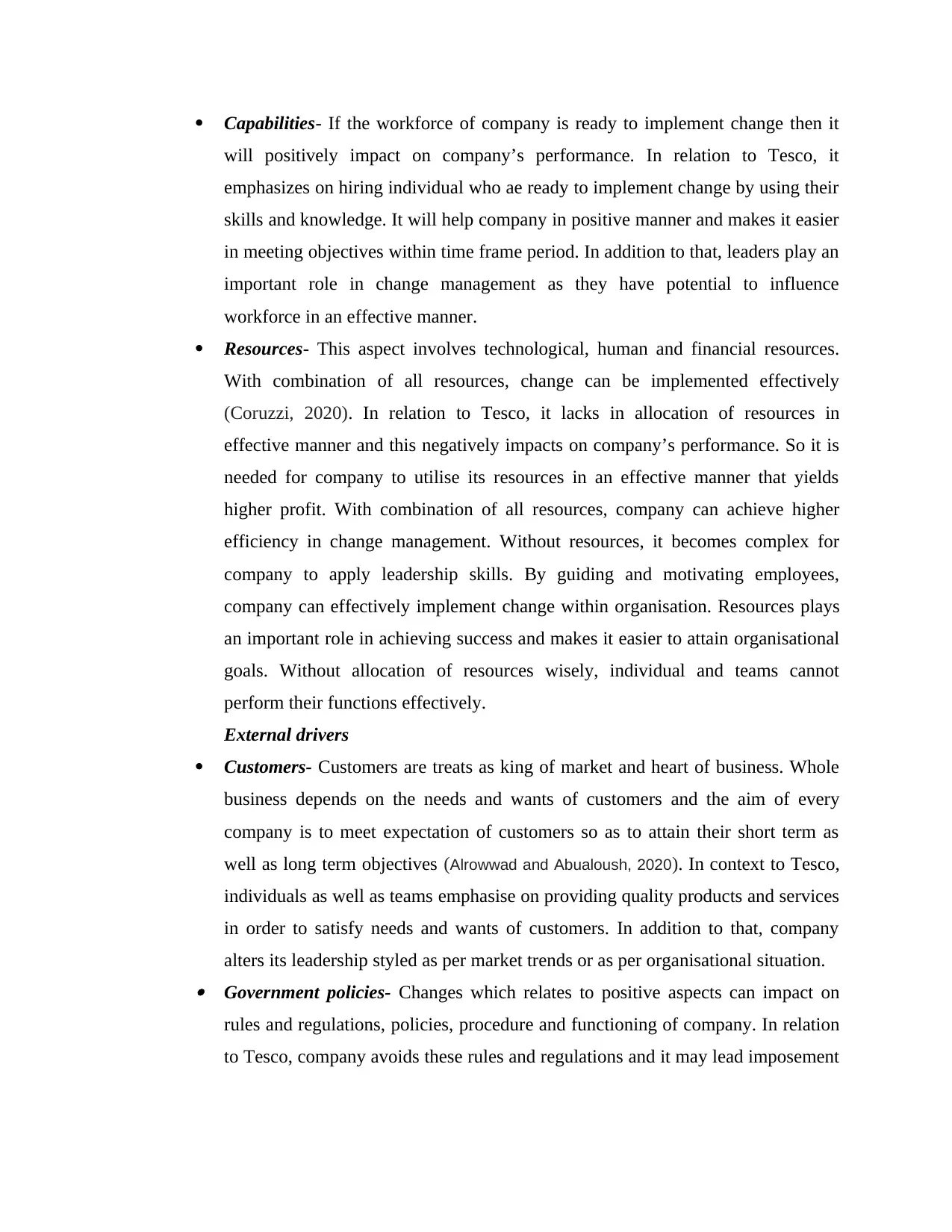
Capabilities- If the workforce of company is ready to implement change then it
will positively impact on company’s performance. In relation to Tesco, it
emphasizes on hiring individual who ae ready to implement change by using their
skills and knowledge. It will help company in positive manner and makes it easier
in meeting objectives within time frame period. In addition to that, leaders play an
important role in change management as they have potential to influence
workforce in an effective manner.
Resources- This aspect involves technological, human and financial resources.
With combination of all resources, change can be implemented effectively
(Coruzzi, 2020). In relation to Tesco, it lacks in allocation of resources in
effective manner and this negatively impacts on company’s performance. So it is
needed for company to utilise its resources in an effective manner that yields
higher profit. With combination of all resources, company can achieve higher
efficiency in change management. Without resources, it becomes complex for
company to apply leadership skills. By guiding and motivating employees,
company can effectively implement change within organisation. Resources plays
an important role in achieving success and makes it easier to attain organisational
goals. Without allocation of resources wisely, individual and teams cannot
perform their functions effectively.
External drivers
Customers- Customers are treats as king of market and heart of business. Whole
business depends on the needs and wants of customers and the aim of every
company is to meet expectation of customers so as to attain their short term as
well as long term objectives (Alrowwad and Abualoush, 2020). In context to Tesco,
individuals as well as teams emphasise on providing quality products and services
in order to satisfy needs and wants of customers. In addition to that, company
alters its leadership styled as per market trends or as per organisational situation.
Government policies- Changes which relates to positive aspects can impact on
rules and regulations, policies, procedure and functioning of company. In relation
to Tesco, company avoids these rules and regulations and it may lead imposement
will positively impact on company’s performance. In relation to Tesco, it
emphasizes on hiring individual who ae ready to implement change by using their
skills and knowledge. It will help company in positive manner and makes it easier
in meeting objectives within time frame period. In addition to that, leaders play an
important role in change management as they have potential to influence
workforce in an effective manner.
Resources- This aspect involves technological, human and financial resources.
With combination of all resources, change can be implemented effectively
(Coruzzi, 2020). In relation to Tesco, it lacks in allocation of resources in
effective manner and this negatively impacts on company’s performance. So it is
needed for company to utilise its resources in an effective manner that yields
higher profit. With combination of all resources, company can achieve higher
efficiency in change management. Without resources, it becomes complex for
company to apply leadership skills. By guiding and motivating employees,
company can effectively implement change within organisation. Resources plays
an important role in achieving success and makes it easier to attain organisational
goals. Without allocation of resources wisely, individual and teams cannot
perform their functions effectively.
External drivers
Customers- Customers are treats as king of market and heart of business. Whole
business depends on the needs and wants of customers and the aim of every
company is to meet expectation of customers so as to attain their short term as
well as long term objectives (Alrowwad and Abualoush, 2020). In context to Tesco,
individuals as well as teams emphasise on providing quality products and services
in order to satisfy needs and wants of customers. In addition to that, company
alters its leadership styled as per market trends or as per organisational situation.
Government policies- Changes which relates to positive aspects can impact on
rules and regulations, policies, procedure and functioning of company. In relation
to Tesco, company avoids these rules and regulations and it may lead imposement
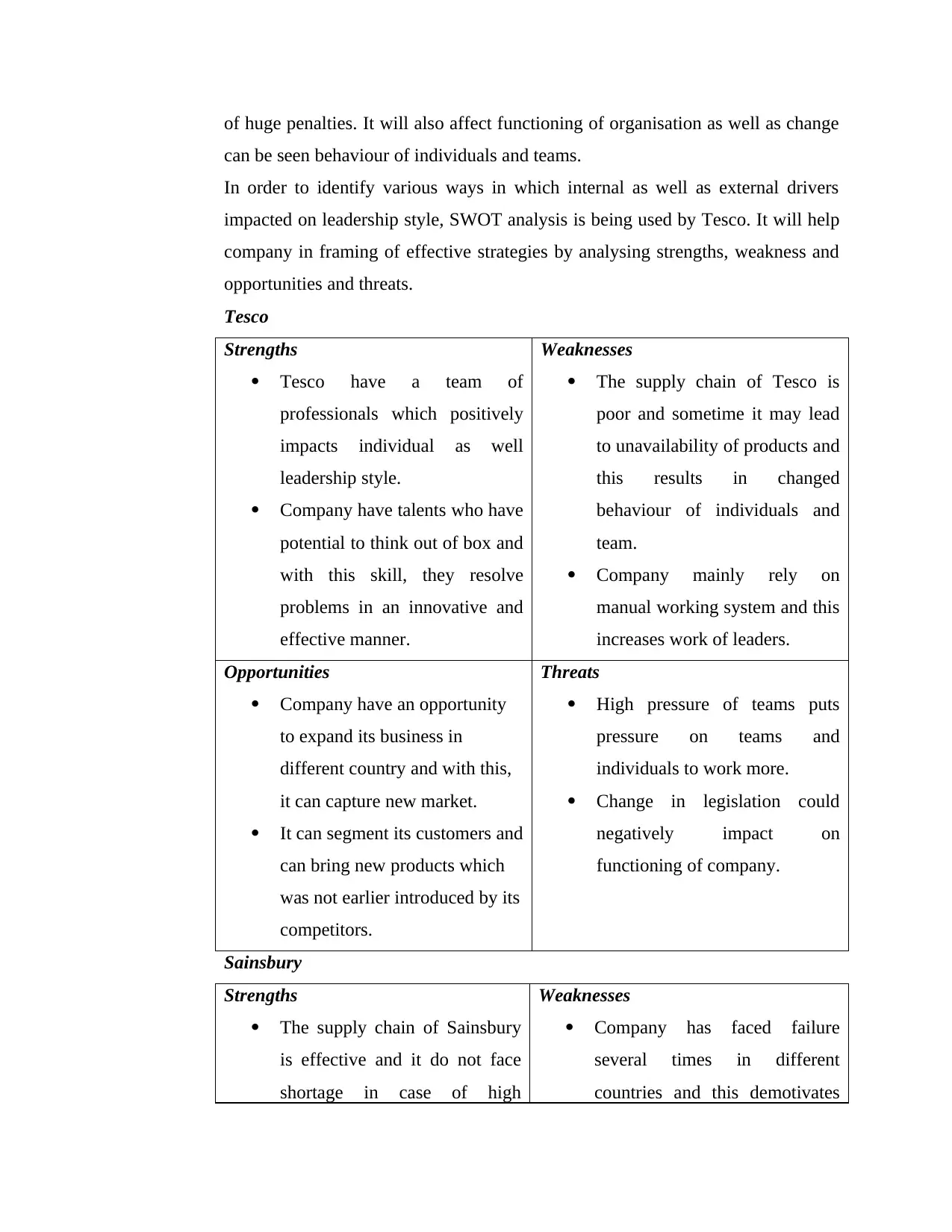
of huge penalties. It will also affect functioning of organisation as well as change
can be seen behaviour of individuals and teams.
In order to identify various ways in which internal as well as external drivers
impacted on leadership style, SWOT analysis is being used by Tesco. It will help
company in framing of effective strategies by analysing strengths, weakness and
opportunities and threats.
Tesco
Strengths
Tesco have a team of
professionals which positively
impacts individual as well
leadership style.
Company have talents who have
potential to think out of box and
with this skill, they resolve
problems in an innovative and
effective manner.
Weaknesses
The supply chain of Tesco is
poor and sometime it may lead
to unavailability of products and
this results in changed
behaviour of individuals and
team.
Company mainly rely on
manual working system and this
increases work of leaders.
Opportunities
Company have an opportunity
to expand its business in
different country and with this,
it can capture new market.
It can segment its customers and
can bring new products which
was not earlier introduced by its
competitors.
Threats
High pressure of teams puts
pressure on teams and
individuals to work more.
Change in legislation could
negatively impact on
functioning of company.
Sainsbury
Strengths
The supply chain of Sainsbury
is effective and it do not face
shortage in case of high
Weaknesses
Company has faced failure
several times in different
countries and this demotivates
can be seen behaviour of individuals and teams.
In order to identify various ways in which internal as well as external drivers
impacted on leadership style, SWOT analysis is being used by Tesco. It will help
company in framing of effective strategies by analysing strengths, weakness and
opportunities and threats.
Tesco
Strengths
Tesco have a team of
professionals which positively
impacts individual as well
leadership style.
Company have talents who have
potential to think out of box and
with this skill, they resolve
problems in an innovative and
effective manner.
Weaknesses
The supply chain of Tesco is
poor and sometime it may lead
to unavailability of products and
this results in changed
behaviour of individuals and
team.
Company mainly rely on
manual working system and this
increases work of leaders.
Opportunities
Company have an opportunity
to expand its business in
different country and with this,
it can capture new market.
It can segment its customers and
can bring new products which
was not earlier introduced by its
competitors.
Threats
High pressure of teams puts
pressure on teams and
individuals to work more.
Change in legislation could
negatively impact on
functioning of company.
Sainsbury
Strengths
The supply chain of Sainsbury
is effective and it do not face
shortage in case of high
Weaknesses
Company has faced failure
several times in different
countries and this demotivates
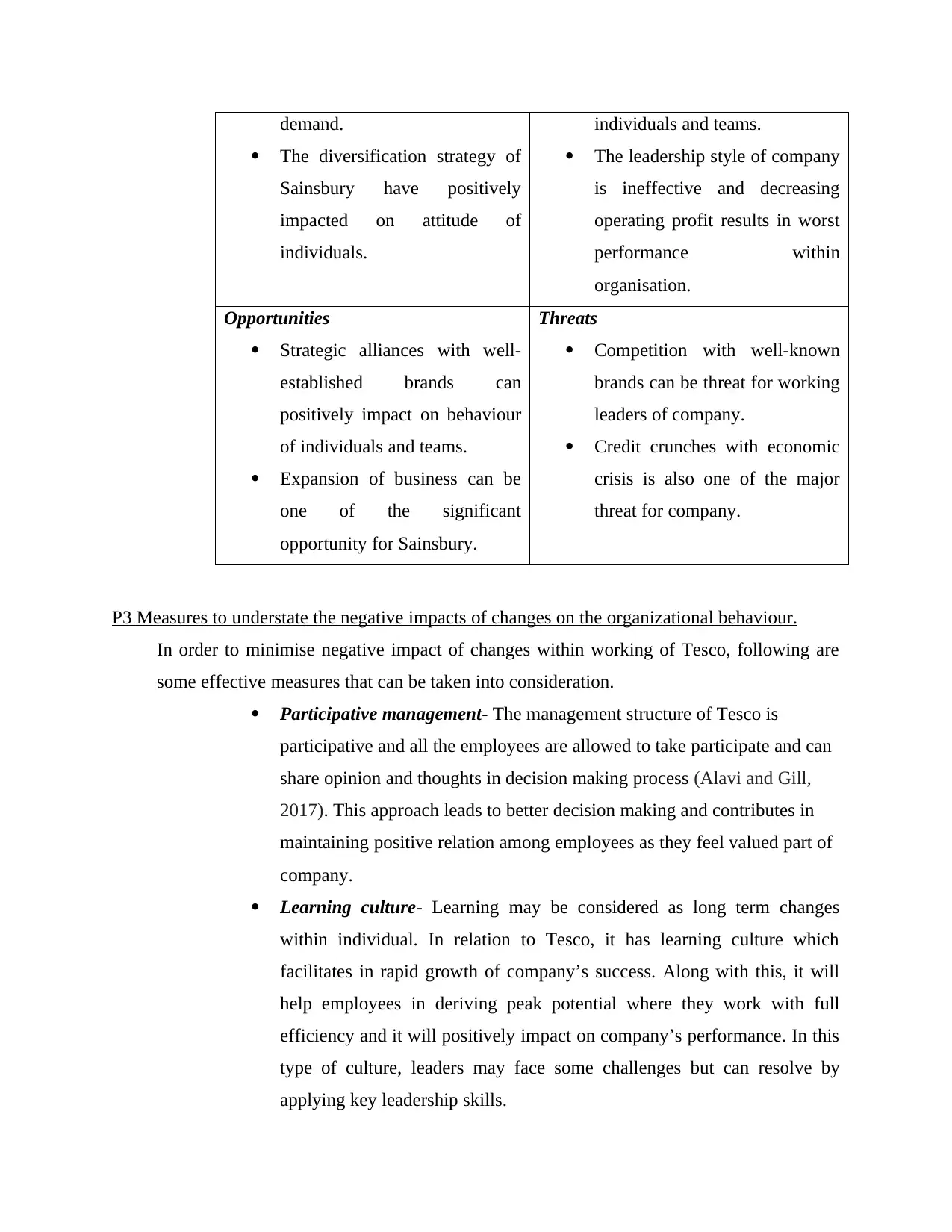
demand.
The diversification strategy of
Sainsbury have positively
impacted on attitude of
individuals.
individuals and teams.
The leadership style of company
is ineffective and decreasing
operating profit results in worst
performance within
organisation.
Opportunities
Strategic alliances with well-
established brands can
positively impact on behaviour
of individuals and teams.
Expansion of business can be
one of the significant
opportunity for Sainsbury.
Threats
Competition with well-known
brands can be threat for working
leaders of company.
Credit crunches with economic
crisis is also one of the major
threat for company.
P3 Measures to understate the negative impacts of changes on the organizational behaviour.
In order to minimise negative impact of changes within working of Tesco, following are
some effective measures that can be taken into consideration.
Participative management- The management structure of Tesco is
participative and all the employees are allowed to take participate and can
share opinion and thoughts in decision making process (Alavi and Gill,
2017). This approach leads to better decision making and contributes in
maintaining positive relation among employees as they feel valued part of
company.
Learning culture- Learning may be considered as long term changes
within individual. In relation to Tesco, it has learning culture which
facilitates in rapid growth of company’s success. Along with this, it will
help employees in deriving peak potential where they work with full
efficiency and it will positively impact on company’s performance. In this
type of culture, leaders may face some challenges but can resolve by
applying key leadership skills.
The diversification strategy of
Sainsbury have positively
impacted on attitude of
individuals.
individuals and teams.
The leadership style of company
is ineffective and decreasing
operating profit results in worst
performance within
organisation.
Opportunities
Strategic alliances with well-
established brands can
positively impact on behaviour
of individuals and teams.
Expansion of business can be
one of the significant
opportunity for Sainsbury.
Threats
Competition with well-known
brands can be threat for working
leaders of company.
Credit crunches with economic
crisis is also one of the major
threat for company.
P3 Measures to understate the negative impacts of changes on the organizational behaviour.
In order to minimise negative impact of changes within working of Tesco, following are
some effective measures that can be taken into consideration.
Participative management- The management structure of Tesco is
participative and all the employees are allowed to take participate and can
share opinion and thoughts in decision making process (Alavi and Gill,
2017). This approach leads to better decision making and contributes in
maintaining positive relation among employees as they feel valued part of
company.
Learning culture- Learning may be considered as long term changes
within individual. In relation to Tesco, it has learning culture which
facilitates in rapid growth of company’s success. Along with this, it will
help employees in deriving peak potential where they work with full
efficiency and it will positively impact on company’s performance. In this
type of culture, leaders may face some challenges but can resolve by
applying key leadership skills.
Secure Best Marks with AI Grader
Need help grading? Try our AI Grader for instant feedback on your assignments.
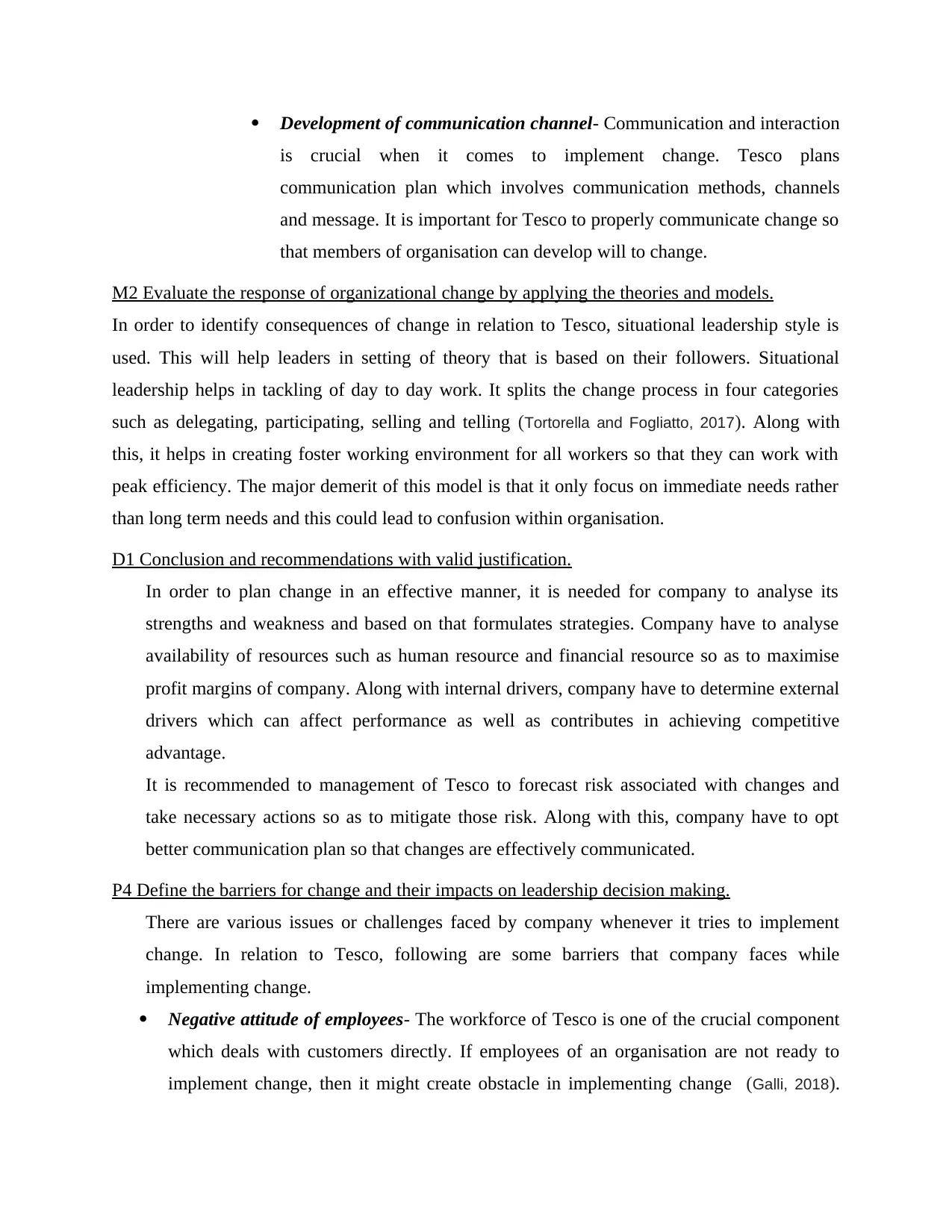
Development of communication channel- Communication and interaction
is crucial when it comes to implement change. Tesco plans
communication plan which involves communication methods, channels
and message. It is important for Tesco to properly communicate change so
that members of organisation can develop will to change.
M2 Evaluate the response of organizational change by applying the theories and models.
In order to identify consequences of change in relation to Tesco, situational leadership style is
used. This will help leaders in setting of theory that is based on their followers. Situational
leadership helps in tackling of day to day work. It splits the change process in four categories
such as delegating, participating, selling and telling (Tortorella and Fogliatto, 2017). Along with
this, it helps in creating foster working environment for all workers so that they can work with
peak efficiency. The major demerit of this model is that it only focus on immediate needs rather
than long term needs and this could lead to confusion within organisation.
D1 Conclusion and recommendations with valid justification.
In order to plan change in an effective manner, it is needed for company to analyse its
strengths and weakness and based on that formulates strategies. Company have to analyse
availability of resources such as human resource and financial resource so as to maximise
profit margins of company. Along with internal drivers, company have to determine external
drivers which can affect performance as well as contributes in achieving competitive
advantage.
It is recommended to management of Tesco to forecast risk associated with changes and
take necessary actions so as to mitigate those risk. Along with this, company have to opt
better communication plan so that changes are effectively communicated.
P4 Define the barriers for change and their impacts on leadership decision making.
There are various issues or challenges faced by company whenever it tries to implement
change. In relation to Tesco, following are some barriers that company faces while
implementing change.
Negative attitude of employees- The workforce of Tesco is one of the crucial component
which deals with customers directly. If employees of an organisation are not ready to
implement change, then it might create obstacle in implementing change (Galli, 2018).
is crucial when it comes to implement change. Tesco plans
communication plan which involves communication methods, channels
and message. It is important for Tesco to properly communicate change so
that members of organisation can develop will to change.
M2 Evaluate the response of organizational change by applying the theories and models.
In order to identify consequences of change in relation to Tesco, situational leadership style is
used. This will help leaders in setting of theory that is based on their followers. Situational
leadership helps in tackling of day to day work. It splits the change process in four categories
such as delegating, participating, selling and telling (Tortorella and Fogliatto, 2017). Along with
this, it helps in creating foster working environment for all workers so that they can work with
peak efficiency. The major demerit of this model is that it only focus on immediate needs rather
than long term needs and this could lead to confusion within organisation.
D1 Conclusion and recommendations with valid justification.
In order to plan change in an effective manner, it is needed for company to analyse its
strengths and weakness and based on that formulates strategies. Company have to analyse
availability of resources such as human resource and financial resource so as to maximise
profit margins of company. Along with internal drivers, company have to determine external
drivers which can affect performance as well as contributes in achieving competitive
advantage.
It is recommended to management of Tesco to forecast risk associated with changes and
take necessary actions so as to mitigate those risk. Along with this, company have to opt
better communication plan so that changes are effectively communicated.
P4 Define the barriers for change and their impacts on leadership decision making.
There are various issues or challenges faced by company whenever it tries to implement
change. In relation to Tesco, following are some barriers that company faces while
implementing change.
Negative attitude of employees- The workforce of Tesco is one of the crucial component
which deals with customers directly. If employees of an organisation are not ready to
implement change, then it might create obstacle in implementing change (Galli, 2018).
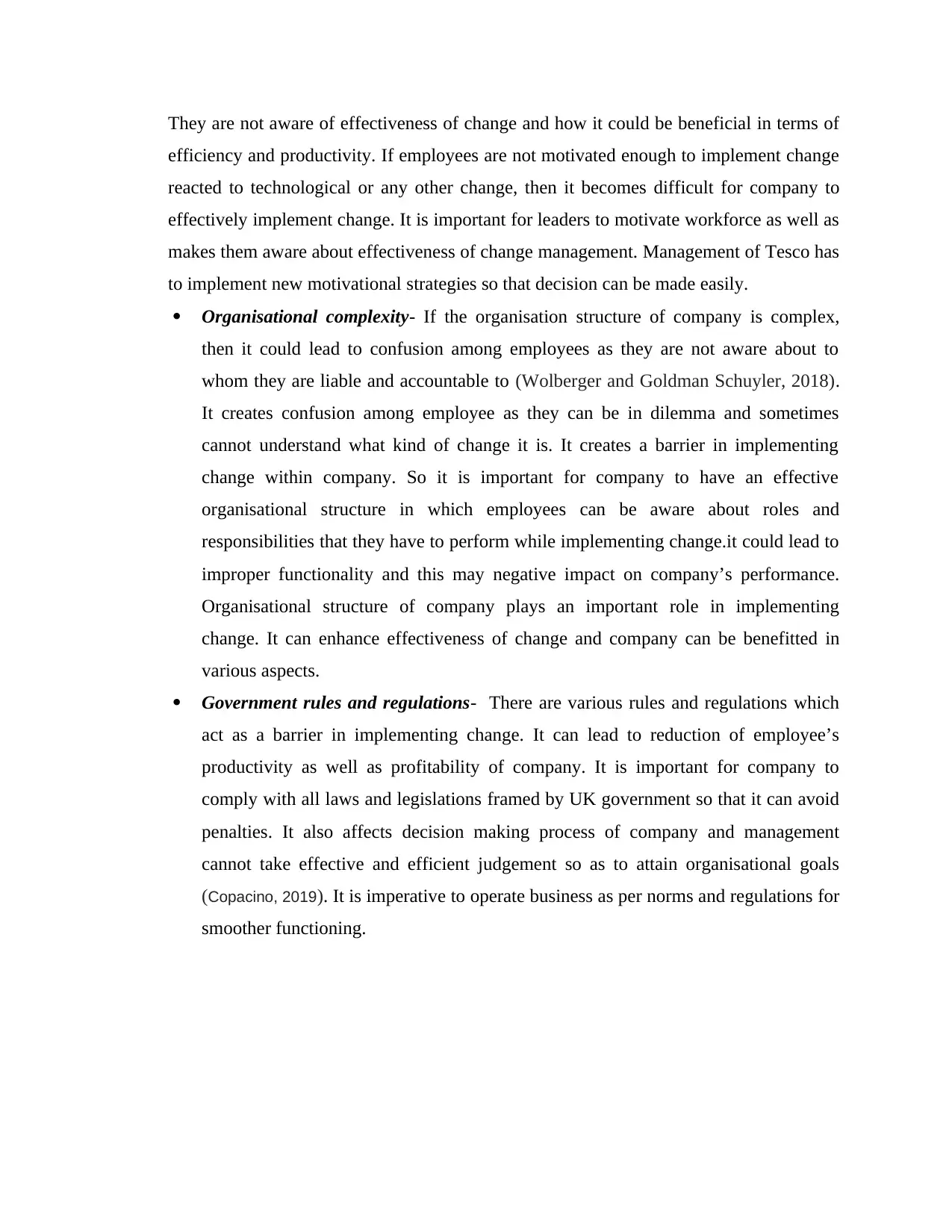
They are not aware of effectiveness of change and how it could be beneficial in terms of
efficiency and productivity. If employees are not motivated enough to implement change
reacted to technological or any other change, then it becomes difficult for company to
effectively implement change. It is important for leaders to motivate workforce as well as
makes them aware about effectiveness of change management. Management of Tesco has
to implement new motivational strategies so that decision can be made easily.
Organisational complexity- If the organisation structure of company is complex,
then it could lead to confusion among employees as they are not aware about to
whom they are liable and accountable to (Wolberger and Goldman Schuyler, 2018).
It creates confusion among employee as they can be in dilemma and sometimes
cannot understand what kind of change it is. It creates a barrier in implementing
change within company. So it is important for company to have an effective
organisational structure in which employees can be aware about roles and
responsibilities that they have to perform while implementing change.it could lead to
improper functionality and this may negative impact on company’s performance.
Organisational structure of company plays an important role in implementing
change. It can enhance effectiveness of change and company can be benefitted in
various aspects.
Government rules and regulations- There are various rules and regulations which
act as a barrier in implementing change. It can lead to reduction of employee’s
productivity as well as profitability of company. It is important for company to
comply with all laws and legislations framed by UK government so that it can avoid
penalties. It also affects decision making process of company and management
cannot take effective and efficient judgement so as to attain organisational goals
(Copacino, 2019). It is imperative to operate business as per norms and regulations for
smoother functioning.
efficiency and productivity. If employees are not motivated enough to implement change
reacted to technological or any other change, then it becomes difficult for company to
effectively implement change. It is important for leaders to motivate workforce as well as
makes them aware about effectiveness of change management. Management of Tesco has
to implement new motivational strategies so that decision can be made easily.
Organisational complexity- If the organisation structure of company is complex,
then it could lead to confusion among employees as they are not aware about to
whom they are liable and accountable to (Wolberger and Goldman Schuyler, 2018).
It creates confusion among employee as they can be in dilemma and sometimes
cannot understand what kind of change it is. It creates a barrier in implementing
change within company. So it is important for company to have an effective
organisational structure in which employees can be aware about roles and
responsibilities that they have to perform while implementing change.it could lead to
improper functionality and this may negative impact on company’s performance.
Organisational structure of company plays an important role in implementing
change. It can enhance effectiveness of change and company can be benefitted in
various aspects.
Government rules and regulations- There are various rules and regulations which
act as a barrier in implementing change. It can lead to reduction of employee’s
productivity as well as profitability of company. It is important for company to
comply with all laws and legislations framed by UK government so that it can avoid
penalties. It also affects decision making process of company and management
cannot take effective and efficient judgement so as to attain organisational goals
(Copacino, 2019). It is imperative to operate business as per norms and regulations for
smoother functioning.

Poor employee engagement- It is most common barrier that many companies faces
that employees are afraid to implement change and with this they keep less
participation in change management process. It is important for company to make
treat employees as assets and it will help in effective change implementation.
Without employee engagement, it becomes complex for company to implement
change and it needs employee engagement in change management process. Company
have to provide all necessary information about change management and how it can
be beneficial for employees as well as for company.
M3. Use force field analysis to evaluate the driving forces.
It is a well-known strategic management tool propounded by Kurt Lewin in
1940. This model helps in analysing balance between factors which assist in implementing
change and what factors limits changes. By using this model, it helps Tesco in evaluating factors
which assist in implementing changes and which not. With this, company can frame effective
strategies which leads to attainment of goals effectively and efficiently.
Driving factors- There are various factors that assist in implementing change. With
change in technology, it will positively impact on functioning of company.it facilitates in
motivating management of company and contributes in enhancing decision.
Technological support in Tesco can affect functioning of company and makes it easier to
perform task. Technology helps in lowering down of overall cost of company and makes
it efficient in terms of profitability (Mohiuddin, 2017).
Restraining forces- Along with driving factors, there are also some forces that do not
support in implementing change and makes process ineffective. It is important for
company to fix those issues so that competitive advantage can be gained. Some of the
factors such as rapid change in technology, lack of workforce participation and lack of
training and guidance can restricts company in implementing change. This may affect
decision making process of company because of negative attitude of employees towards
change management.
In accordance to Force Field Analysis, it has been evaluated that company have to focus
on motivating employees so as to make them ready for implementing change. Apart from
this, company should address restraining forces by taking corrective decisions. It is
important for Tesco to frame effective strategies so that employees are ready to
that employees are afraid to implement change and with this they keep less
participation in change management process. It is important for company to make
treat employees as assets and it will help in effective change implementation.
Without employee engagement, it becomes complex for company to implement
change and it needs employee engagement in change management process. Company
have to provide all necessary information about change management and how it can
be beneficial for employees as well as for company.
M3. Use force field analysis to evaluate the driving forces.
It is a well-known strategic management tool propounded by Kurt Lewin in
1940. This model helps in analysing balance between factors which assist in implementing
change and what factors limits changes. By using this model, it helps Tesco in evaluating factors
which assist in implementing changes and which not. With this, company can frame effective
strategies which leads to attainment of goals effectively and efficiently.
Driving factors- There are various factors that assist in implementing change. With
change in technology, it will positively impact on functioning of company.it facilitates in
motivating management of company and contributes in enhancing decision.
Technological support in Tesco can affect functioning of company and makes it easier to
perform task. Technology helps in lowering down of overall cost of company and makes
it efficient in terms of profitability (Mohiuddin, 2017).
Restraining forces- Along with driving factors, there are also some forces that do not
support in implementing change and makes process ineffective. It is important for
company to fix those issues so that competitive advantage can be gained. Some of the
factors such as rapid change in technology, lack of workforce participation and lack of
training and guidance can restricts company in implementing change. This may affect
decision making process of company because of negative attitude of employees towards
change management.
In accordance to Force Field Analysis, it has been evaluated that company have to focus
on motivating employees so as to make them ready for implementing change. Apart from
this, company should address restraining forces by taking corrective decisions. It is
important for Tesco to frame effective strategies so that employees are ready to
Paraphrase This Document
Need a fresh take? Get an instant paraphrase of this document with our AI Paraphraser
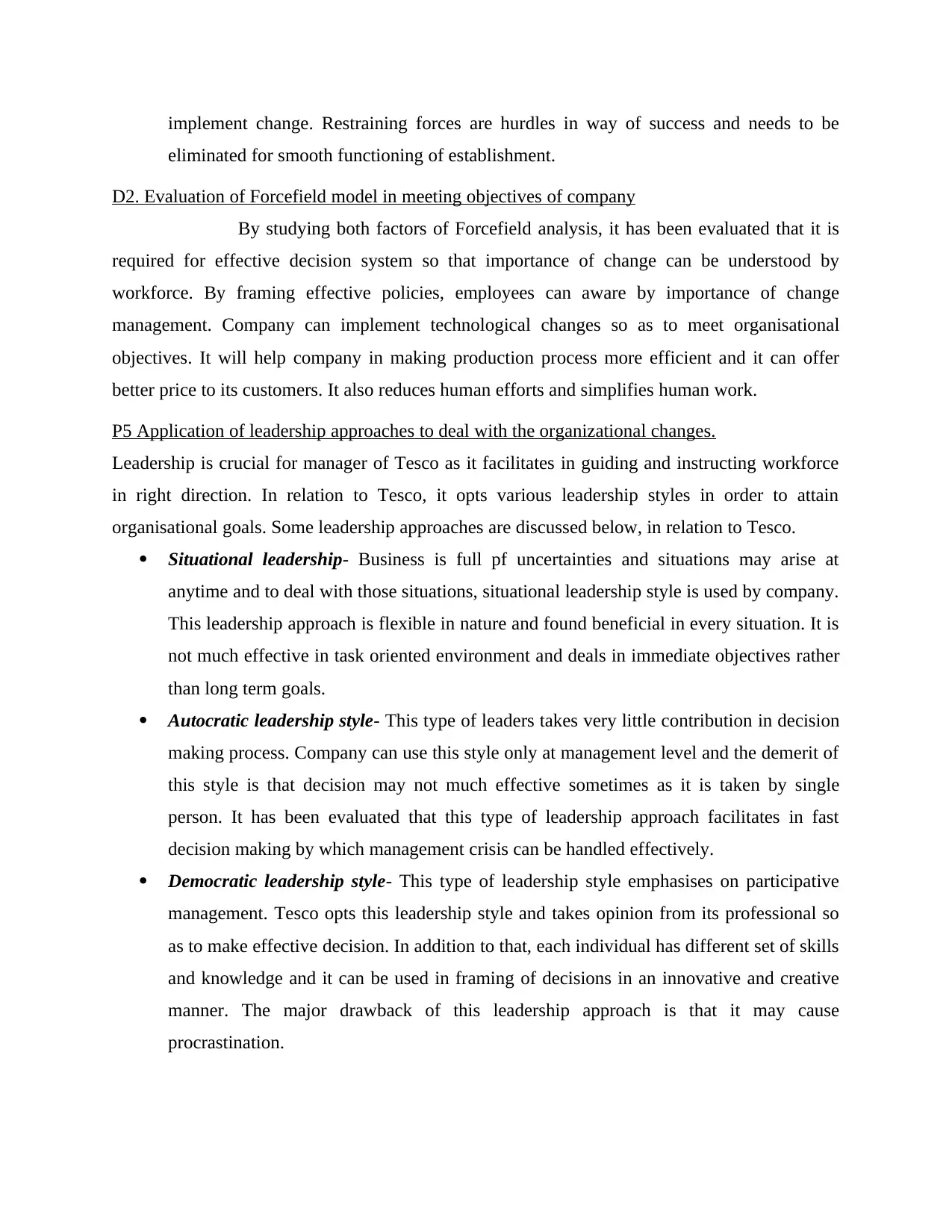
implement change. Restraining forces are hurdles in way of success and needs to be
eliminated for smooth functioning of establishment.
D2. Evaluation of Forcefield model in meeting objectives of company
By studying both factors of Forcefield analysis, it has been evaluated that it is
required for effective decision system so that importance of change can be understood by
workforce. By framing effective policies, employees can aware by importance of change
management. Company can implement technological changes so as to meet organisational
objectives. It will help company in making production process more efficient and it can offer
better price to its customers. It also reduces human efforts and simplifies human work.
P5 Application of leadership approaches to deal with the organizational changes.
Leadership is crucial for manager of Tesco as it facilitates in guiding and instructing workforce
in right direction. In relation to Tesco, it opts various leadership styles in order to attain
organisational goals. Some leadership approaches are discussed below, in relation to Tesco.
Situational leadership- Business is full pf uncertainties and situations may arise at
anytime and to deal with those situations, situational leadership style is used by company.
This leadership approach is flexible in nature and found beneficial in every situation. It is
not much effective in task oriented environment and deals in immediate objectives rather
than long term goals.
Autocratic leadership style- This type of leaders takes very little contribution in decision
making process. Company can use this style only at management level and the demerit of
this style is that decision may not much effective sometimes as it is taken by single
person. It has been evaluated that this type of leadership approach facilitates in fast
decision making by which management crisis can be handled effectively.
Democratic leadership style- This type of leadership style emphasises on participative
management. Tesco opts this leadership style and takes opinion from its professional so
as to make effective decision. In addition to that, each individual has different set of skills
and knowledge and it can be used in framing of decisions in an innovative and creative
manner. The major drawback of this leadership approach is that it may cause
procrastination.
eliminated for smooth functioning of establishment.
D2. Evaluation of Forcefield model in meeting objectives of company
By studying both factors of Forcefield analysis, it has been evaluated that it is
required for effective decision system so that importance of change can be understood by
workforce. By framing effective policies, employees can aware by importance of change
management. Company can implement technological changes so as to meet organisational
objectives. It will help company in making production process more efficient and it can offer
better price to its customers. It also reduces human efforts and simplifies human work.
P5 Application of leadership approaches to deal with the organizational changes.
Leadership is crucial for manager of Tesco as it facilitates in guiding and instructing workforce
in right direction. In relation to Tesco, it opts various leadership styles in order to attain
organisational goals. Some leadership approaches are discussed below, in relation to Tesco.
Situational leadership- Business is full pf uncertainties and situations may arise at
anytime and to deal with those situations, situational leadership style is used by company.
This leadership approach is flexible in nature and found beneficial in every situation. It is
not much effective in task oriented environment and deals in immediate objectives rather
than long term goals.
Autocratic leadership style- This type of leaders takes very little contribution in decision
making process. Company can use this style only at management level and the demerit of
this style is that decision may not much effective sometimes as it is taken by single
person. It has been evaluated that this type of leadership approach facilitates in fast
decision making by which management crisis can be handled effectively.
Democratic leadership style- This type of leadership style emphasises on participative
management. Tesco opts this leadership style and takes opinion from its professional so
as to make effective decision. In addition to that, each individual has different set of skills
and knowledge and it can be used in framing of decisions in an innovative and creative
manner. The major drawback of this leadership approach is that it may cause
procrastination.
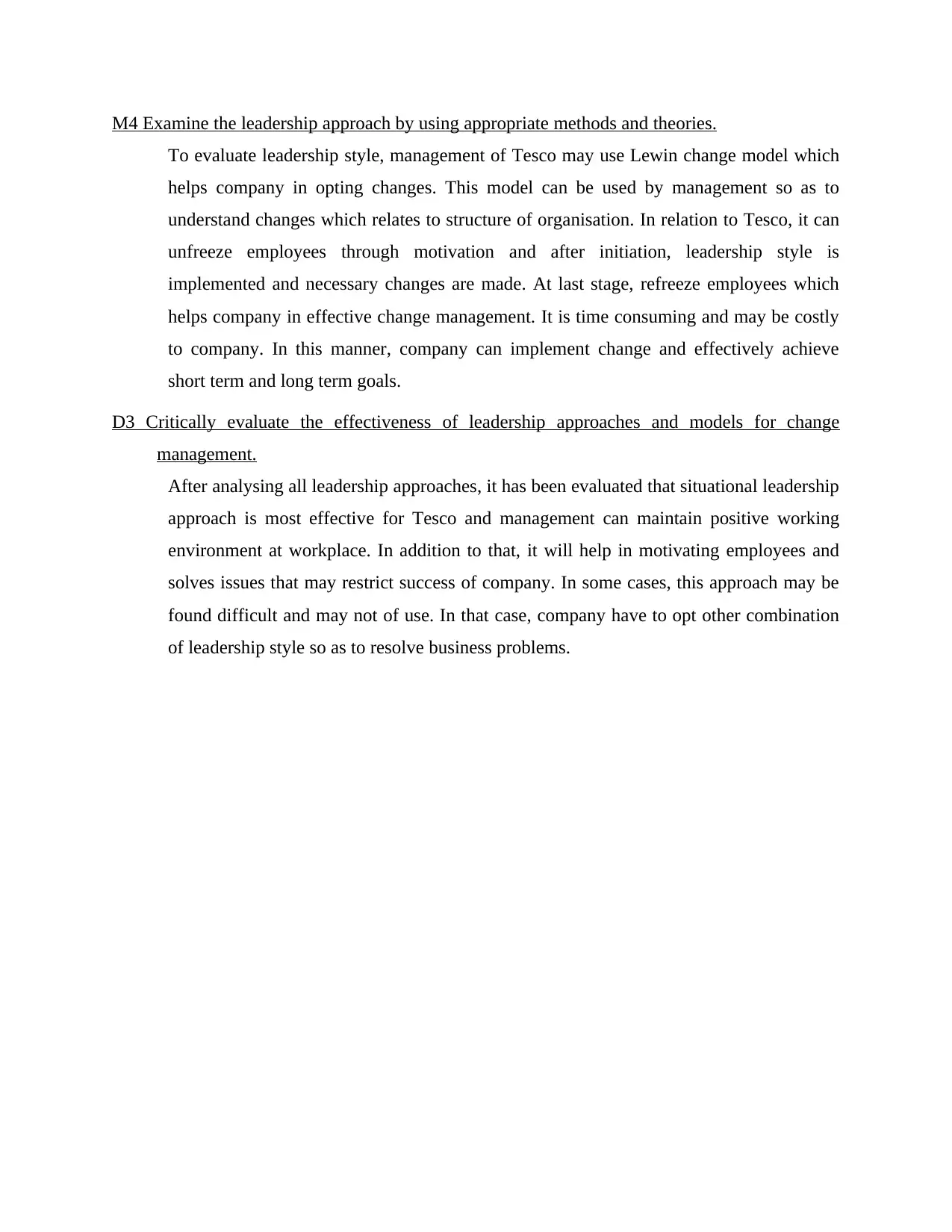
M4 Examine the leadership approach by using appropriate methods and theories.
To evaluate leadership style, management of Tesco may use Lewin change model which
helps company in opting changes. This model can be used by management so as to
understand changes which relates to structure of organisation. In relation to Tesco, it can
unfreeze employees through motivation and after initiation, leadership style is
implemented and necessary changes are made. At last stage, refreeze employees which
helps company in effective change management. It is time consuming and may be costly
to company. In this manner, company can implement change and effectively achieve
short term and long term goals.
D3 Critically evaluate the effectiveness of leadership approaches and models for change
management.
After analysing all leadership approaches, it has been evaluated that situational leadership
approach is most effective for Tesco and management can maintain positive working
environment at workplace. In addition to that, it will help in motivating employees and
solves issues that may restrict success of company. In some cases, this approach may be
found difficult and may not of use. In that case, company have to opt other combination
of leadership style so as to resolve business problems.
To evaluate leadership style, management of Tesco may use Lewin change model which
helps company in opting changes. This model can be used by management so as to
understand changes which relates to structure of organisation. In relation to Tesco, it can
unfreeze employees through motivation and after initiation, leadership style is
implemented and necessary changes are made. At last stage, refreeze employees which
helps company in effective change management. It is time consuming and may be costly
to company. In this manner, company can implement change and effectively achieve
short term and long term goals.
D3 Critically evaluate the effectiveness of leadership approaches and models for change
management.
After analysing all leadership approaches, it has been evaluated that situational leadership
approach is most effective for Tesco and management can maintain positive working
environment at workplace. In addition to that, it will help in motivating employees and
solves issues that may restrict success of company. In some cases, this approach may be
found difficult and may not of use. In that case, company have to opt other combination
of leadership style so as to resolve business problems.
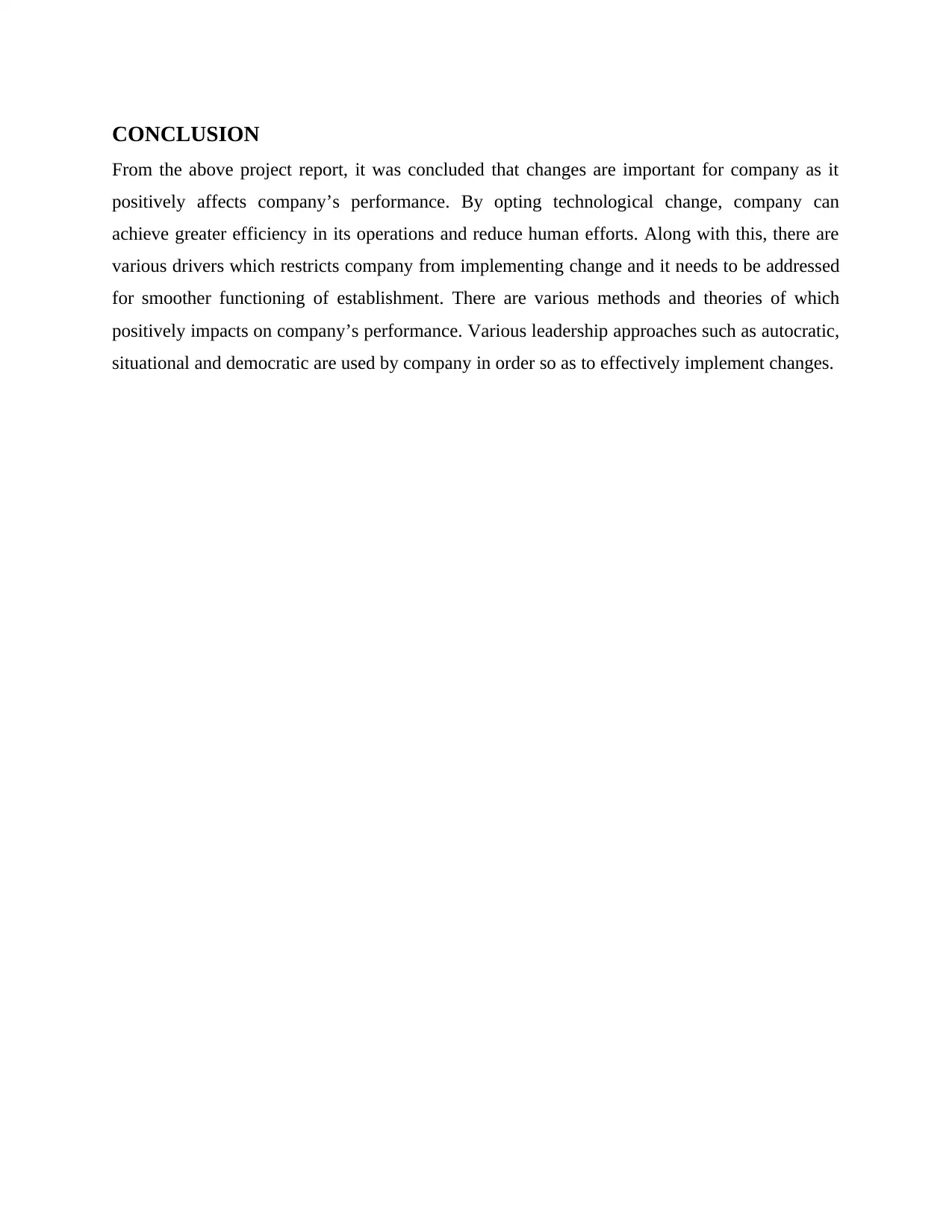
CONCLUSION
From the above project report, it was concluded that changes are important for company as it
positively affects company’s performance. By opting technological change, company can
achieve greater efficiency in its operations and reduce human efforts. Along with this, there are
various drivers which restricts company from implementing change and it needs to be addressed
for smoother functioning of establishment. There are various methods and theories of which
positively impacts on company’s performance. Various leadership approaches such as autocratic,
situational and democratic are used by company in order so as to effectively implement changes.
From the above project report, it was concluded that changes are important for company as it
positively affects company’s performance. By opting technological change, company can
achieve greater efficiency in its operations and reduce human efforts. Along with this, there are
various drivers which restricts company from implementing change and it needs to be addressed
for smoother functioning of establishment. There are various methods and theories of which
positively impacts on company’s performance. Various leadership approaches such as autocratic,
situational and democratic are used by company in order so as to effectively implement changes.
Secure Best Marks with AI Grader
Need help grading? Try our AI Grader for instant feedback on your assignments.
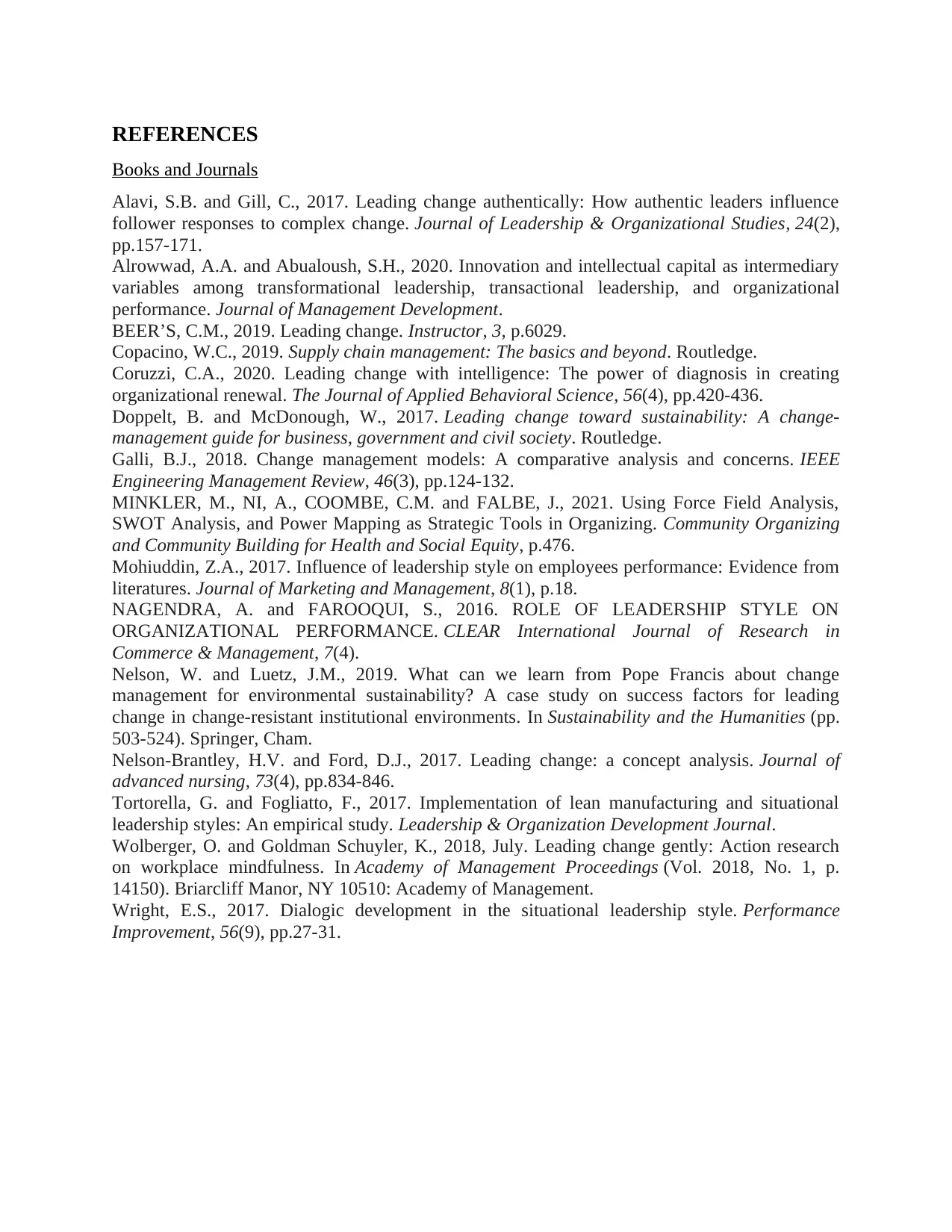
REFERENCES
Books and Journals
Alavi, S.B. and Gill, C., 2017. Leading change authentically: How authentic leaders influence
follower responses to complex change. Journal of Leadership & Organizational Studies, 24(2),
pp.157-171.
Alrowwad, A.A. and Abualoush, S.H., 2020. Innovation and intellectual capital as intermediary
variables among transformational leadership, transactional leadership, and organizational
performance. Journal of Management Development.
BEER’S, C.M., 2019. Leading change. Instructor, 3, p.6029.
Copacino, W.C., 2019. Supply chain management: The basics and beyond. Routledge.
Coruzzi, C.A., 2020. Leading change with intelligence: The power of diagnosis in creating
organizational renewal. The Journal of Applied Behavioral Science, 56(4), pp.420-436.
Doppelt, B. and McDonough, W., 2017. Leading change toward sustainability: A change-
management guide for business, government and civil society. Routledge.
Galli, B.J., 2018. Change management models: A comparative analysis and concerns. IEEE
Engineering Management Review, 46(3), pp.124-132.
MINKLER, M., NI, A., COOMBE, C.M. and FALBE, J., 2021. Using Force Field Analysis,
SWOT Analysis, and Power Mapping as Strategic Tools in Organizing. Community Organizing
and Community Building for Health and Social Equity, p.476.
Mohiuddin, Z.A., 2017. Influence of leadership style on employees performance: Evidence from
literatures. Journal of Marketing and Management, 8(1), p.18.
NAGENDRA, A. and FAROOQUI, S., 2016. ROLE OF LEADERSHIP STYLE ON
ORGANIZATIONAL PERFORMANCE. CLEAR International Journal of Research in
Commerce & Management, 7(4).
Nelson, W. and Luetz, J.M., 2019. What can we learn from Pope Francis about change
management for environmental sustainability? A case study on success factors for leading
change in change-resistant institutional environments. In Sustainability and the Humanities (pp.
503-524). Springer, Cham.
Nelson‐Brantley, H.V. and Ford, D.J., 2017. Leading change: a concept analysis. Journal of
advanced nursing, 73(4), pp.834-846.
Tortorella, G. and Fogliatto, F., 2017. Implementation of lean manufacturing and situational
leadership styles: An empirical study. Leadership & Organization Development Journal.
Wolberger, O. and Goldman Schuyler, K., 2018, July. Leading change gently: Action research
on workplace mindfulness. In Academy of Management Proceedings (Vol. 2018, No. 1, p.
14150). Briarcliff Manor, NY 10510: Academy of Management.
Wright, E.S., 2017. Dialogic development in the situational leadership style. Performance
Improvement, 56(9), pp.27-31.
Books and Journals
Alavi, S.B. and Gill, C., 2017. Leading change authentically: How authentic leaders influence
follower responses to complex change. Journal of Leadership & Organizational Studies, 24(2),
pp.157-171.
Alrowwad, A.A. and Abualoush, S.H., 2020. Innovation and intellectual capital as intermediary
variables among transformational leadership, transactional leadership, and organizational
performance. Journal of Management Development.
BEER’S, C.M., 2019. Leading change. Instructor, 3, p.6029.
Copacino, W.C., 2019. Supply chain management: The basics and beyond. Routledge.
Coruzzi, C.A., 2020. Leading change with intelligence: The power of diagnosis in creating
organizational renewal. The Journal of Applied Behavioral Science, 56(4), pp.420-436.
Doppelt, B. and McDonough, W., 2017. Leading change toward sustainability: A change-
management guide for business, government and civil society. Routledge.
Galli, B.J., 2018. Change management models: A comparative analysis and concerns. IEEE
Engineering Management Review, 46(3), pp.124-132.
MINKLER, M., NI, A., COOMBE, C.M. and FALBE, J., 2021. Using Force Field Analysis,
SWOT Analysis, and Power Mapping as Strategic Tools in Organizing. Community Organizing
and Community Building for Health and Social Equity, p.476.
Mohiuddin, Z.A., 2017. Influence of leadership style on employees performance: Evidence from
literatures. Journal of Marketing and Management, 8(1), p.18.
NAGENDRA, A. and FAROOQUI, S., 2016. ROLE OF LEADERSHIP STYLE ON
ORGANIZATIONAL PERFORMANCE. CLEAR International Journal of Research in
Commerce & Management, 7(4).
Nelson, W. and Luetz, J.M., 2019. What can we learn from Pope Francis about change
management for environmental sustainability? A case study on success factors for leading
change in change-resistant institutional environments. In Sustainability and the Humanities (pp.
503-524). Springer, Cham.
Nelson‐Brantley, H.V. and Ford, D.J., 2017. Leading change: a concept analysis. Journal of
advanced nursing, 73(4), pp.834-846.
Tortorella, G. and Fogliatto, F., 2017. Implementation of lean manufacturing and situational
leadership styles: An empirical study. Leadership & Organization Development Journal.
Wolberger, O. and Goldman Schuyler, K., 2018, July. Leading change gently: Action research
on workplace mindfulness. In Academy of Management Proceedings (Vol. 2018, No. 1, p.
14150). Briarcliff Manor, NY 10510: Academy of Management.
Wright, E.S., 2017. Dialogic development in the situational leadership style. Performance
Improvement, 56(9), pp.27-31.
1 out of 17
Related Documents
Your All-in-One AI-Powered Toolkit for Academic Success.
+13062052269
info@desklib.com
Available 24*7 on WhatsApp / Email
![[object Object]](/_next/static/media/star-bottom.7253800d.svg)
Unlock your academic potential
© 2024 | Zucol Services PVT LTD | All rights reserved.




